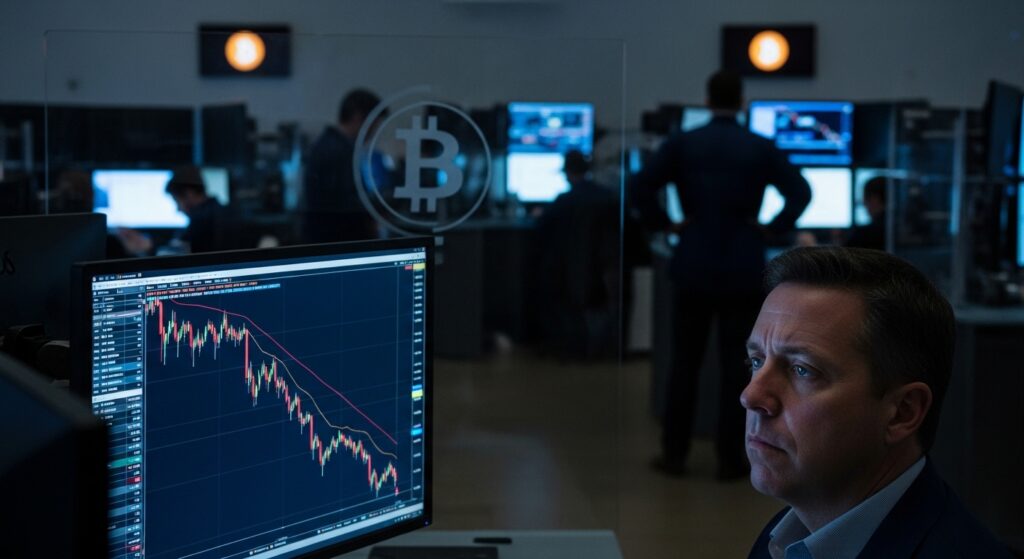The chill of a crypto winter feels more like a deep freeze for companies that hold bitcoin as their main treasury asset. These firms, often called Bitcoin Treasury Companies (BTCTCs), aimed to follow in the footsteps of Michael Saylor’s MicroStrategy. Many went public in 2025, perhaps seeing a lenient US regulatory environment as an invitation.
- Bitcoin Treasury Companies (BTCTCs) are facing significant losses, with share prices tumbling long before recent bitcoin price dips.
- Executives are actively defending their business models and reassuring shareholders amidst investor concerns and comparisons to past crypto failures.
- While some executives point to potential long-term value and lessons from past market downturns, the current mood for BTCTCs is decidedly negative, suggesting a need for more than just hoping for bitcoin’s price to rise.
The results have been stark. Investors have seen significant losses almost across the board. While the recent dip in bitcoin’s price, falling from over $126,000 to $106,939.48 in just eleven days, certainly added to the pain, BTCTC share prices were already tumbling long before that.
Consider a small group of these companies. Over the past three months, losses have ranged from a “mere” 38% for Strategy (the new name for MicroStrategy) to a staggering 94% for KindlyMD, trading under the ticker NAKA. It makes you wonder what kind of investor stomach is required for this ride.
The Echo of “Steady Lads”
The phrase “Deploying more capital — steady lads” has become a familiar, if slightly grim, meme in crypto circles. It harks back to May 2022, when Do Kwon, the founder of TerraUSD, posted it as his algorithmic stablecoin began to lose its peg to the dollar. Within days, TerraUSD, once valued at about $50 billion, was worthless. The phrase now pops up whenever things start to look shaky for markets or companies.
I should make it clear. This isn’t to suggest any wrongdoing or to predict a similar fate for today’s BTCTCs. But the sheer volume of social media activity from some executive teams has certainly caught my eye. They’ve been busy defending their business models, trying to reassure worried shareholders.
Take Simon Gerovich, CEO of Japan’s Metaplanet. His company’s shares are still up since adopting the BTCTC strategy in 2024. However, they’ve seen a 70% decline over the last three months. On a recent Friday, Gerovich tried to explain how issuing preferred stock could deliver strong returns.
He posted on X, explaining, “When bitcoin appreciates faster than the cost of capital, that difference compounds into greater bitcoin per share and the benefit accrues to the common shareholders.”
When bitcoin appreciates faster than the cost of capital, that difference compounds into greater bitcoin per share and the benefit accrues to the common shareholders. pic.twitter.com/2iXq4F12Wf
— Simon Gerovich (@gerovich) October 4, 2025
The short version of his message? Metaplanet investors will do well if the “number go up.” It’s a simple, almost poetic, summary of the bitcoin bull case, isn’t it?
Then there’s David Bailey, CEO of KindlyMD. His company’s shares have plunged 94% in three months. The stock price now sits below $1, putting it at risk of being delisted by the Nasdaq. On a Thursday, Bailey felt it necessary to respond to claims from an X poster who suggested his company had “FTX vibes.”
In no way is there any similarity to FTX. We’re a regulated, registered security that buys and holds bitcoin. pic.twitter.com/y4L266p9S
— David F. Bailey (@DavidFBailey) October 3, 2025
Bailey stated, “In no way is there any similarity to FTX. We’re a regulated, registered security that buys and holds bitcoin.” When a CEO of a publicly traded company has to address a random social media post to deny comparisons to a collapsed, scandal-ridden exchange, it’s a sign that things might be a bit off track.
Charting a Path Forward
Ben Werkman, CIO of Strive, has also seen his company’s share price nearly match NAKA’s steep decline. Strive faces its own delisting concerns. Werkman offered a lengthy explanation on X, trying to clarify the current difficulties and outline a way forward for these companies.
He wrote, “Now the exuberance is gone, and many companies are now in position with their balance sheets intact to be able to move to the second phase of the journey.” Werkman suggested that achieving scale was once hard, but many companies now have it. He believes valuations are reaching “deep value territory” based on balance sheets alone. This, he argues, is where long-term investors will place their bets.
Now the exuberance is gone, and many companies are now in position with their balance sheets intact to be able to move to the second phase of the journey. Achieving scale is difficult, but now many companies have it. Valuations are reaching what I would consider deep value territory (just based on balance sheets alone), and these are the valuations where many investors will place their bets for the long term. Many assumed Saylor’s Strategy (then MicroStrategy) was going to zero in 2022’s crypto winter. Those who faded that assumption were rewarded with mind-boggling returns. MSTR was trading at about $30 when Do Kwon made his “steady lads” post. Even after their recent decline, the shares are still at $290 — or nearly a 10-bagger over the last three and a half years.
— Ben Werkman (@BenWerkman) October 1, 2025
Werkman also reminded readers of Strategy’s own journey. Many thought Michael Saylor’s company was headed for zero during the 2022 crypto winter. Those who ignored that assumption were rewarded handsomely. Strategy’s shares were around $30 when Do Kwon made his famous “steady lads” post. Even after their recent dip, those shares are still trading at $290. That’s nearly a ten-fold return over three and a half years. It’s quite a lesson in patience, isn’t it?
The current mood among BTCTCs is far from positive. While the dream of replicating Strategy’s massive success remains, it seems clear that simply waiting for bitcoin’s price to rise might not be enough for these latecomers. They may need a more robust strategy to weather the storm and truly thrive.

